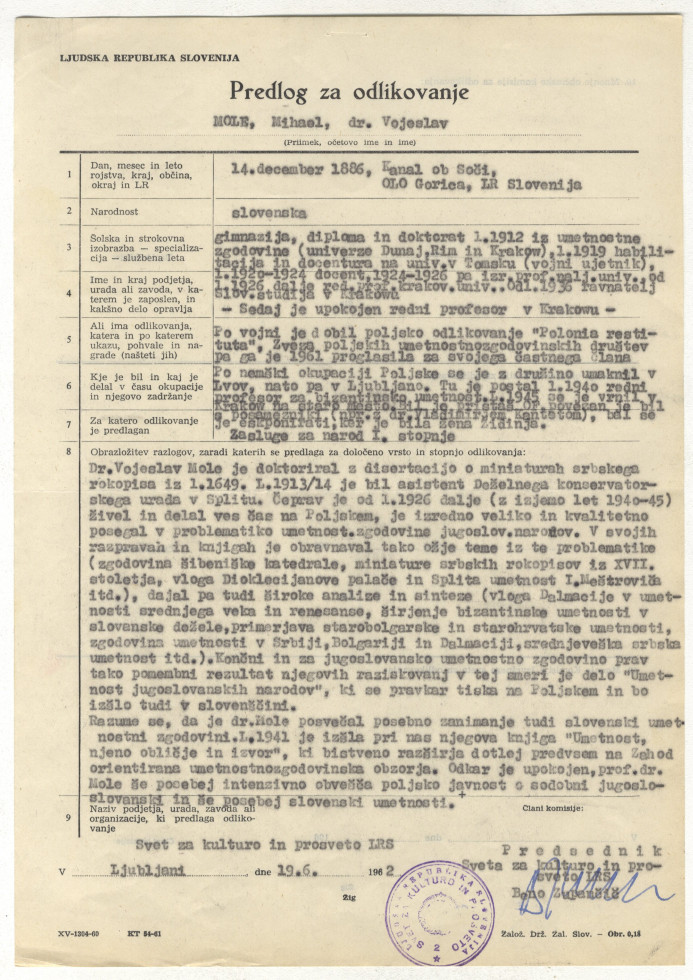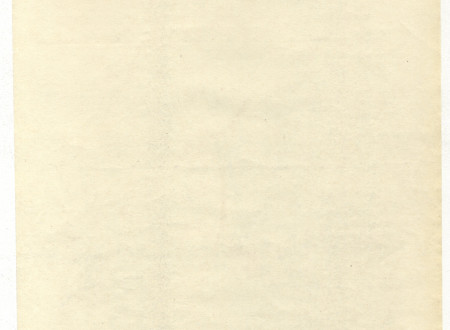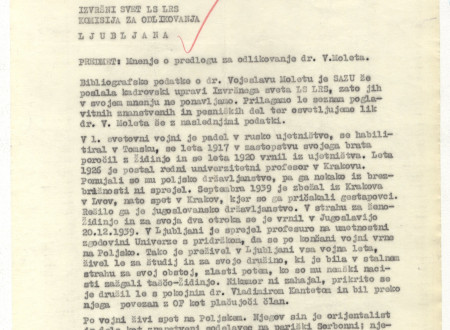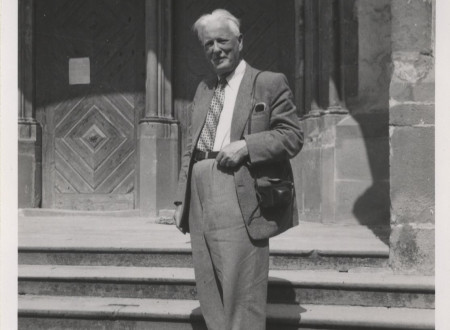A Proposal to Confer Decoration on Dr. Vojeslav Mole
In the month of December, the extraordinary life of Dr. Vojeslav Molè, prominent Slovenian art historian, classical archaeologist, poet, writer and translator, came to an end. This month’s archivalia – a proposal for conferring the Order of Merits for the People (1st rank) to Vojeslav Molè – presents his curriculum vitae up to 1962. Drawn up by the Council on Culture and Education of the People’s Republic of Slovenia on June 19, 1962, the proposal was submitted to the Decoration Awarding Commission of the Executive Council of the People’s Republic of Slovenia. Judging from the data available, the proposal was never confirmed by the commission.
Vojeslav Molè was born on December 14, 1886 to a family of a lower ranking military clerk in Kanal ob Soči. Having completed the first three years of primary school in Sežana, he then attended grammar school preparatory class in Prosek, and the first semester of grammar school in Trieste (1898). The family then moved to Novo mesto, where Molè remained for the next eight years and finished his grammar school. During this time his first attempts at literature were published in magazines such as Ljubljanski zvon and Omladina, the journal of the Slovenian academic society in Vienna. After his graduation, he enrolled in the University of Law in Vienna in 1906 but switched to Slavic and Romance studies after just one semester. In the spring of the next year he began his military service and after one-year in the army in Trieste (1907-1908), where he also attended and finished officer training school, he left for Krakow in the autumn of 1908 and for a year attended lectures on Polish literature and Slavic linguistics. During his stay there he met his future wife Ela Brumer (1890-1975), who at the time was a student of polonistics and art history and a talented pianist (later also a translator of some of Ivan Cankar’s novels). In Krakow, Molè also began publishing his first professional articles. The following year (1909-1910) he was in Rome, preparing for the study of art history, which he continued in Vienna between 1910 and 1912. During summer vacation he worked in a notary’s archive, collecting archival material pertaining to the history of the Šibenik Cathedral. In the spring of 1912, he received his doctorate in art history and classic archaeology in Vienna. Having completed his studies, he embarked on a year’s journey around Italy as an Austrian government’s scholarship holder. In October 1913, he landed his first job, working for the Central Commission for the Preservation of Monuments in Vienna, which assigned him to the Provincial Conservation Office in Split.
The outbreak of WWI saw Molè mobilized into the Austrian army as reserve officer on August 1, 1914. He was appointed commander of the railway station in Przemyśl in Poland, but was soon, at his own wish, transferred to the Russian front. Not long after fighting his first battles in September he found himself in the POW captivity in Siberia, where he spent the next six years. On April 11, 1917 he married Ela Brumer by proxy (he was represented by his brother). At the start of 1919, he joined the 1st Yugoslav regiment “Matija Gubec”. In the autumn of 1919 he held lectures at the university of Tomsk and was even habilitated , but in December that same year he embarked on his long journey back to Krakow, reaching his destination in the spring of 1920. Soon after their return, Molè and his wife moved to Ljubljana for five years. On September 1, 1920, Molè was appointed assistant professor of classical archaeology and Byzantine art at the University of Ljubljana, advancing to associate professor in three years’ time. In the autumn of 1925, he and his family moved to Krakow, where he stayed for the whole 14 years until the Second World War and for additional 19 years after the war. He worked as a full professor of Slavic art history in the newly established Institute for Slavic Studies of the Jagiellonian University (in 1936 he was even appointed dean). After German invasion of Poland, Molè and his family were in the autumn of 1939 evacuated to the besieged Lvov. From there they departed for Ljubljana, where Molè worked as a professor of Byzantine studies at the University of Ljubljana and where he and his family awaited the end of the war.
In the autumn of 1945, after six years of absence, the Molè family returned to Krakow. He resumed his scientific and pedagogical work as a professor of art history at the Institute of Slavic Studies at Jagiellonian University. In 1947, he was elected a full member of the Polish Academy of Science in Krakow, and in 1950 he became the head of the Institute of Art History of the Jagiellonian University and of the Medieval Art Department. Retiring in 1960, he was elected corresponding member of the Slovenian Academy of Science and Arts the following year. In 1966, Molè and his wife moved to stay with their daughter in Oregon. He died on December 5, 1973 in the city of Eugene in Oregon, USA.
Literary, scientific and professional work of Vojeslav Molè is extremely diverse and rich. He issued stylistically perfected Parnassian collection of poems titled Ko so cvetele rože(When Flowers Bloomed) (1910) and Tristia ex Siberia (1920). Through his critical work and essays he established a connection between the Poles and the Slovenians, and penetrated the world of early Christian and Byzantine art when discussing the issue of “Orient or Rome”, opting for the decisive share of the Mediterranean cultural world. He searched for similarities among different forms of art created by the Slavic nations, published books on Russian and South Slavic art, and stressed the dividing line between eastern and western culture, believing that this line had its roots in antiquity and went directly across the territory of the former Yugoslavia. He considered art as one of the fundamental functions of culture, and perceived an artist as the decisive factor in any cultural development. He acquainted the Poles with Slovenian literary achievements, and introduced Polish art to the Slovenians. He described his life in his “autobiography of a humanist” titled Iz knjige spominov(From the Book of Memories) (1970).
Personal fonds of Vojeslav Molè (SI AS 2161, 12 archival boxes of records dating from 1903 to 1975) was transferred to the Archives of the Republic of Slovenia in 2017 as a donation from Molè’s daughter Jadwiga. Among various records (box 9) we can also see his photo taken in Ptujska Gora in the summer of 1957.
Jernej Križaj





